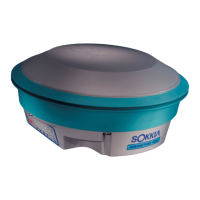
Do you have a question about the Sokkia GSR2700 ISX and is the answer not in the manual?
| Type | GNSS Receiver |
|---|---|
| GPS Tracking | Yes |
| SBAS Tracking | Yes |
| Accuracy (RTK) Horizontal | 8 mm + 1 ppm |
| Accuracy (RTK) Vertical | 15 mm + 1 ppm |
| Data Storage | Internal Memory |
| Static Accuracy (Vertical) | 10 mm + 1 ppm |
| Kinematic Accuracy (Horizontal) | 10 mm + 1 ppm |
| Communication | Bluetooth, USB |
| Power Supply | External power or internal battery |
| Weight | 1.5 kg |
| Frequency | L1, L2, L5 |
Provides an overview of the GSR2700 ISX as an integrated, high-precision GNSS solution.
Details the various modes of operation and key features of the GSR2700 ISX receiver.
Lists and describes the standard components included with the GSR2700 ISX system configuration.
Highlights important safety precautions and warnings for handling and operating the GSR2700 ISX.
Guides users on how to contact technical support and what information to provide.
Describes the physical characteristics and protective bumper of the GSR2700 ISX enclosure.
Details the external power, communication, and antenna ports located on the underside of the unit.
Explains the keyed and color-coded connectors for connecting cables to the receiver.
Discusses the internal Li-Ion battery packs and their operational run times in various configurations.
Outlines the internal memory capacity and its use for supporting post-processing applications.
Describes the integrated GPS and GLONASS antenna with Pinwheel technology and height measurement point.
Covers the optional internal UHF or GSM/GPRS radio for differential correction transmission or reception.
Details the built-in Class 2 Bluetooth device supporting multiple concurrent connections.
Explains the easy-to-use display panel with single-button operation and LED indicators for system status.
Describes the audible annunciator that provides voice messages or sounds for system status and events.
Explains how to turn the unit on/off, format memory, or perform a factory reset using the power button.
Introduces the four display panel gauges providing battery life, satellite tracking, memory, and time status.
Details the various status indicators on the display panel for receiver health, COM ports, wireless, and radio.
Lists and describes the conditions that trigger voice messages or sounds from the receiver.
Outlines the general sequence of operations for using the GSR2700 ISX receiver.
Details how to configure the GSR2700 ISX or transfer data to a PC in an office environment.
Provides an overview of equipment and setup for typical field uses like RTK and static surveys.
Explains the procedure for powering the GSR2700 ISX receiver on and off using the power button.
Describes powering the receiver using internal batteries or an external power source.
Details how the GSR2700 ISX can provide power to connected peripheral devices through its COM ports.
Explains how the receiver behaves during power failure and steps to restore operation.
Provides instructions on how to charge the internal batteries of the GSR2700 ISX using the AC adapter.
Explains how raw data is collected, recorded as time-tagged measurements, and stored in unique data files.
Details methods for collecting data using a handheld controller or receiver's internal memory with POWERUP.
Describes the convention for auto-generated file names consisting of an eight-character base and .PDC extension.
Provides approximate hours of data logging based on recording intervals and internal memory capacity.
Explains how to restore the default factory POWERUP configuration by pressing the power button.
Describes how to delete all files from the receiver's memory using the power button.
Details the physical dimensions, weight, and enclosure construction of the GSR2700 ISX.
Lists operating and storage temperatures, humidity, dust/water protection, and shock resistance.
Covers receiver technology, channels, time to first fix, signal reacquisition, and data update rate.
Provides accuracy figures for Static, Rapid Static, Kinematic, and WAAS/EGNOS modes.
Specifies external and internal power input, consumption, and battery capacity/voltage.
Details UHF and GSM/GPRS radio frequencies, power, and connector types.
Step-by-step guide to configure a data collector for Bluetooth communication with the GSR2700 ISX receiver.
Introduces the Satel Satelline 3ASd and Epic radios and their similarities.
Explains how to connect Satel radios to the GSR2700 ISX using specific cables.
Guides users through setting frequency, output power, and error correction for Satel radios.
Describes how to configure a Satel radio to function as a repeater for extended RTK range.
Instructions on how to download the necessary USB driver from the POINT website.
Step-by-step guide for installing the USB driver on Windows XP and Windows 2000.
Explains how to view and modify properties of USB virtual COM ports after driver installation.
Discusses driver signing policies and how to adjust them for driver installation.
